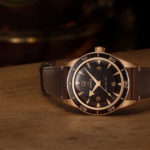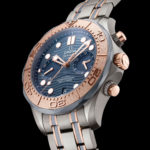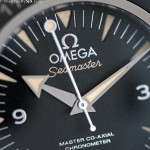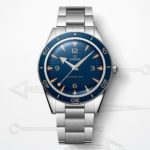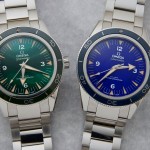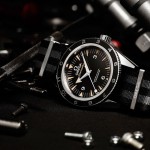Up Close: Omega Seamaster 300 Bronze Gold
A unique proposition that's subtle and stable.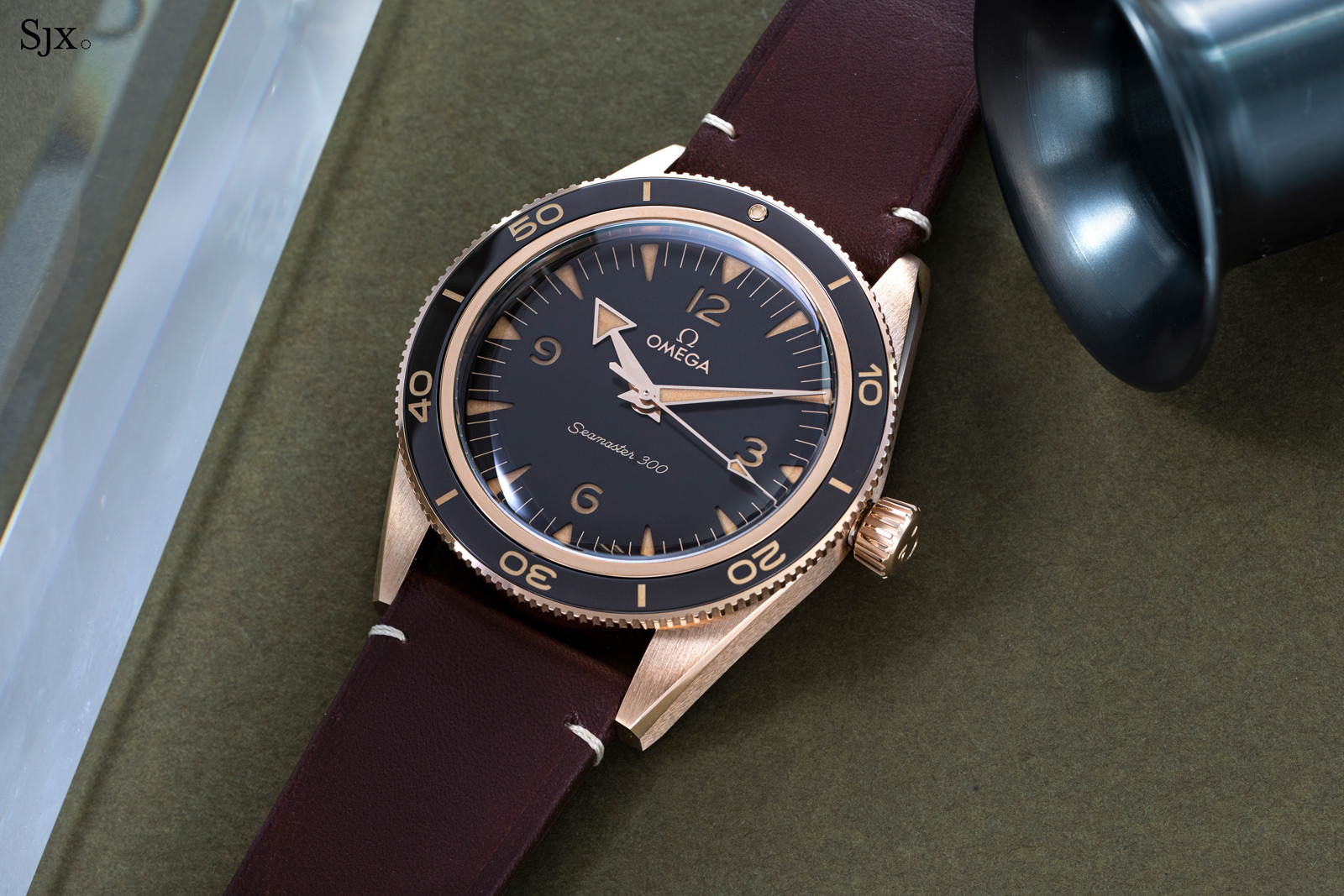
A surprise launch that was part of last year’s revamp of its retro diver, the Omega Seamaster 300 Bronze Gold is marked the debut of a new gold alloy, joining the brand’s ever-growing stable of proprietary metals like as Moonshine and Sedna golds.
The unusual nature of the gold alloy – with a good proportion of copper, it is only 9k in terms of purity – immediately makes the new Seamaster 300 interesting. It stands out amongst the sea of vintage-inspired dive watches thanks to the unique physical properties of the case metal, which will develop a patina, but in a slow, barely discernible manner.
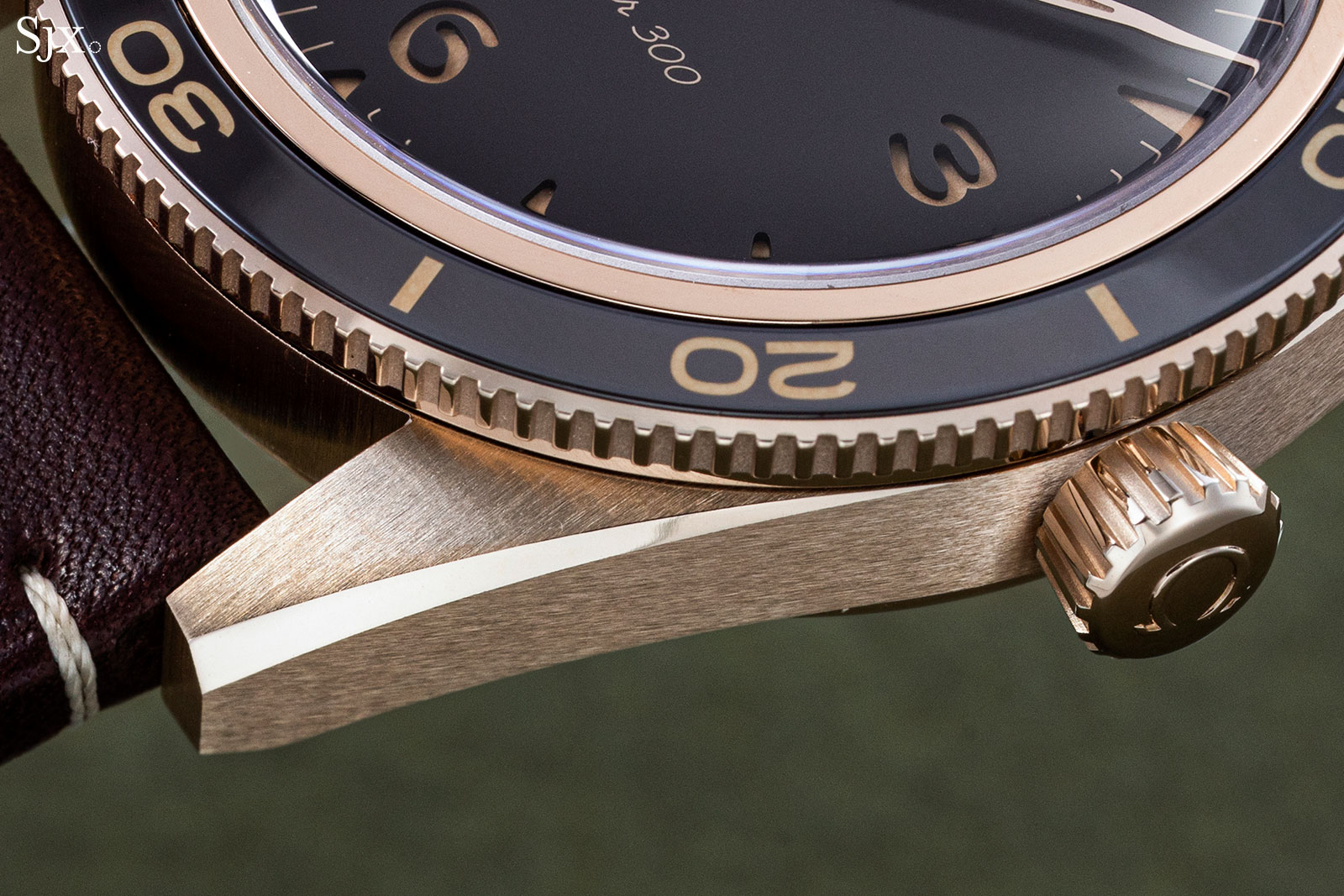
The alloy is 37.5% gold, which is 9k
But because the Seamaster 300 Bronze Gold is still gold, even if it is low caratage, it is not especially affordable, being twice that of its steel counterpart. That said, from the perspective of conventional gold, it’s much more accessible compared to a typical dive watch with an 18k gold case.
With that contradiction in mind, is the Seamaster 300 Bronze Gold a value proposition? Omega was kind enough to lend one for a week, so I endeavoured to find out.
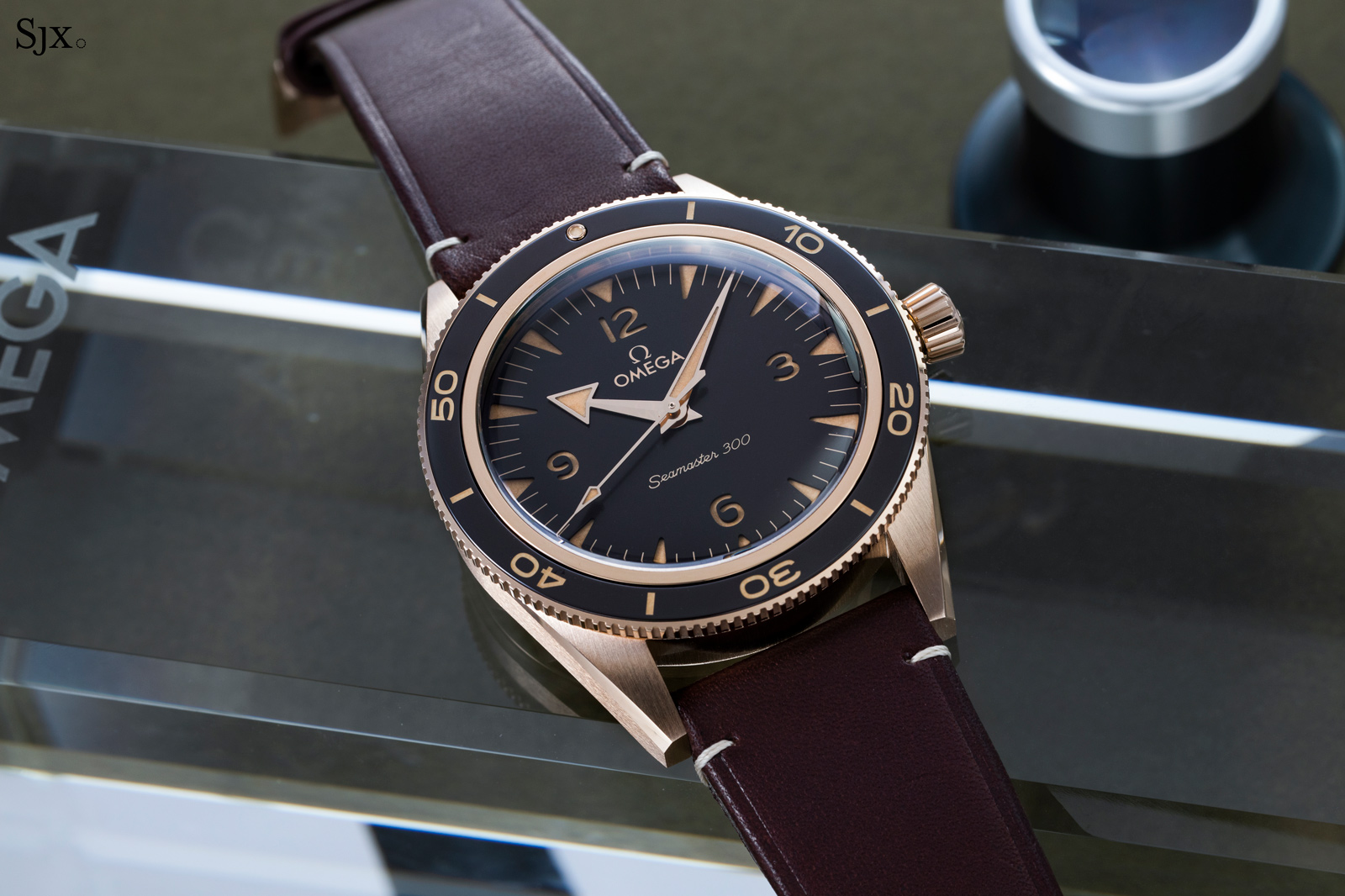
Initial thoughts
First things first, the aesthetics. The watch is handsome in the metal, with an appealing style that is evidently vintage-inspired despite the thick case. And it definitely feels more luxurious than the steel versions, in part due to the case metal but also the seemingly finer details.
Overall, the design feels complete and cohesive – the brown colourway is appealing in its consistency. It’s a warm, natural palette that brings with it a nostalgic feel that’s uncommon in modern watches, but entirely fitting for a design rooted in the 1950s original.
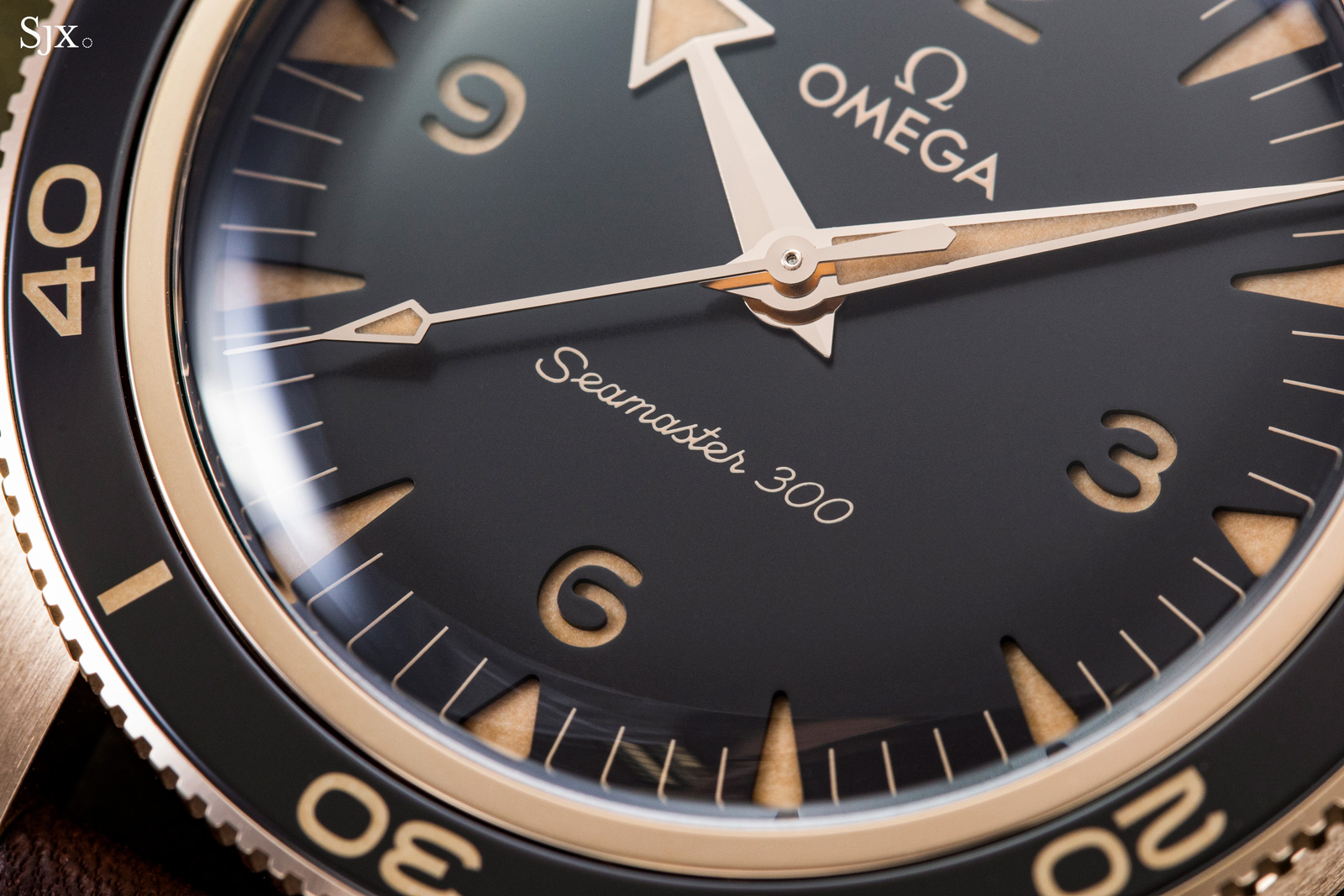
Aesthetics aside, also in its favour is the excellent cal. 8912, the no-date version of the cal. 8900 found across the Omega line-up. The cal. 8912 has a thoughtful, practical construction, with features like a quick-set hour hand, as well as an appealing, industrial decoration.
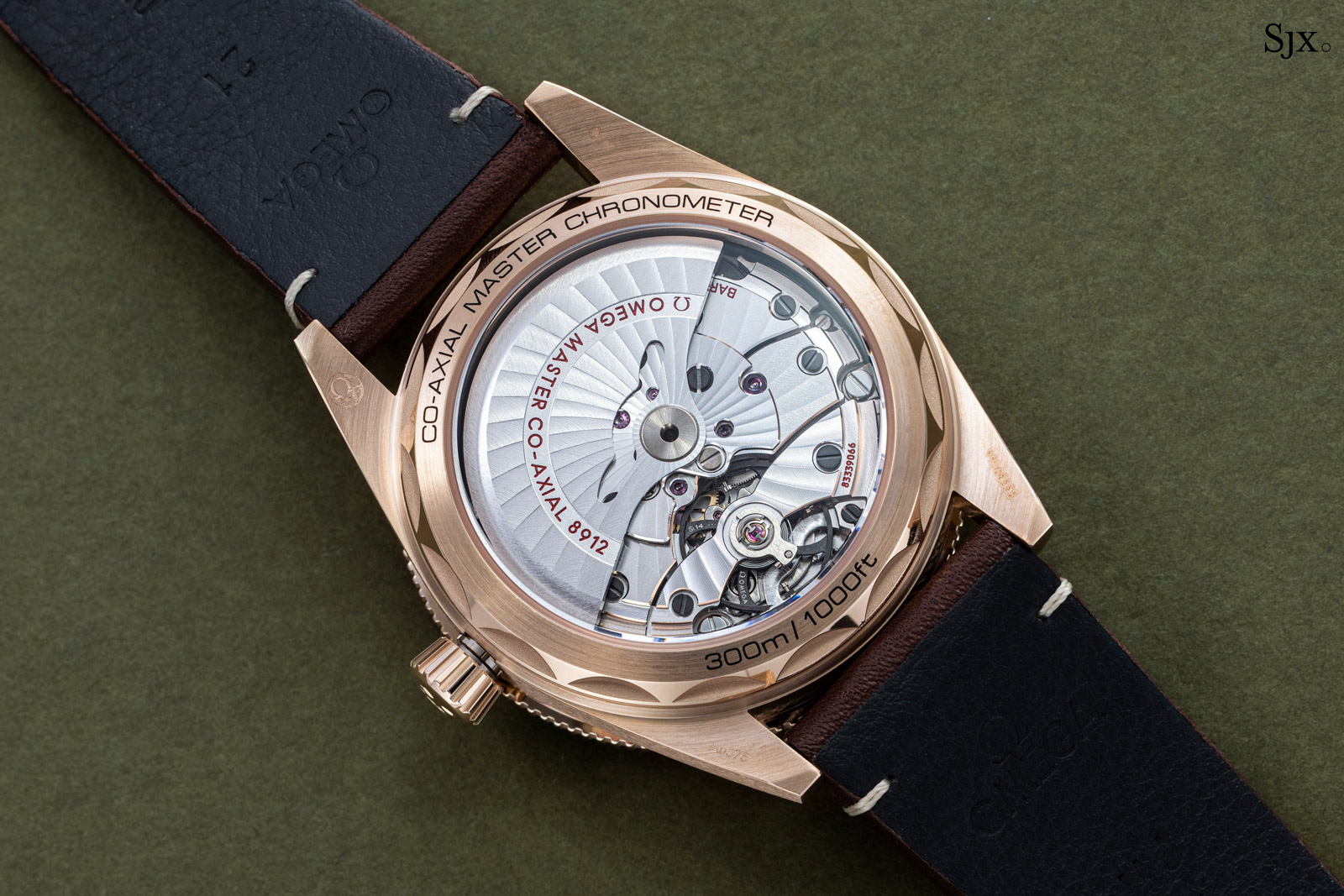
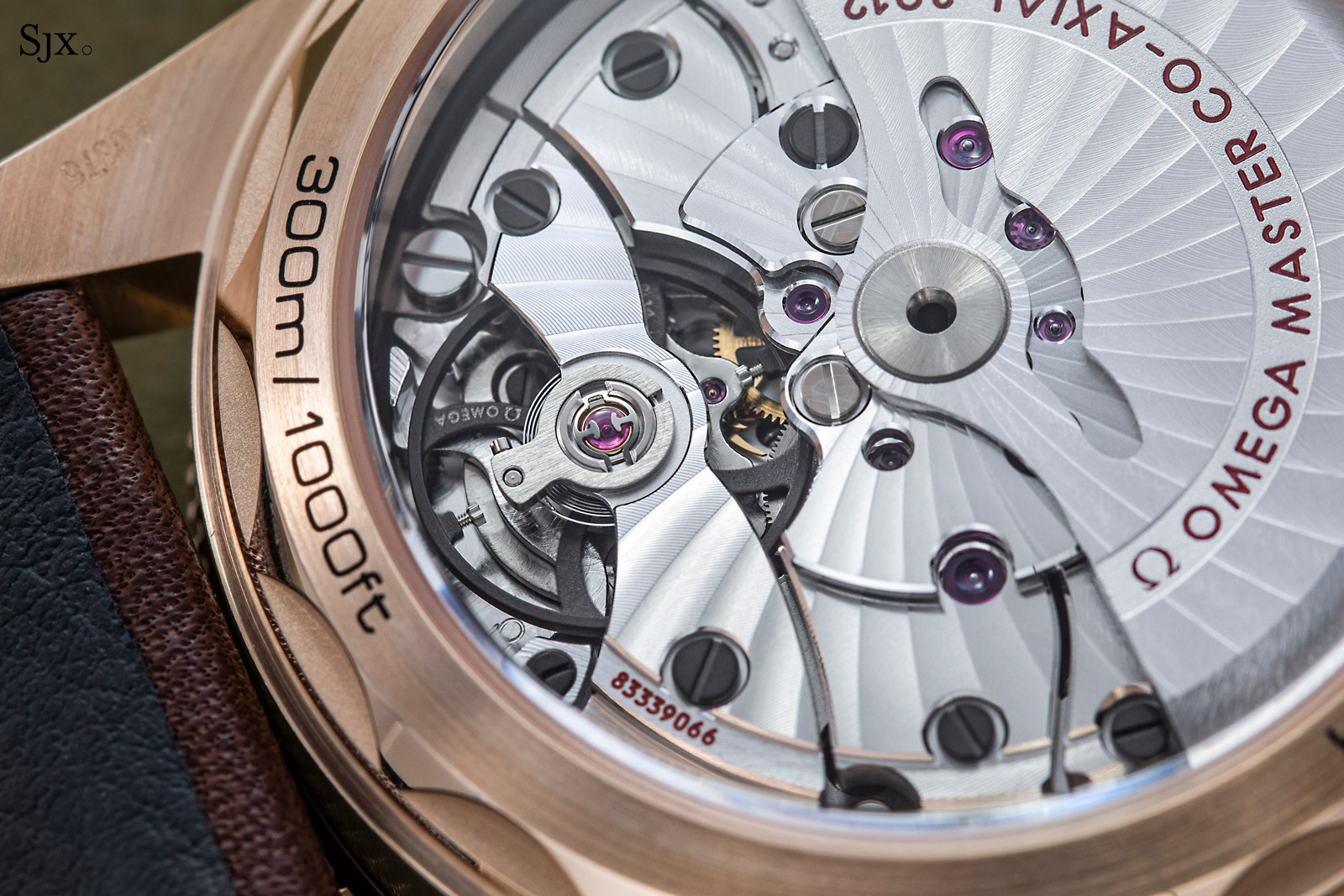
More importantly, the watch occupies a unique position within the retro dive watch segment. While watches with a similar style are common, most of them are steel or bronze, so the Bronze Gold alloy is instantly distinctive in both physical composition and aesthetics.
Bronze dive watches are popular because of the physical characteristics of the alloy, which develops a patina over time as a result of surface oxidisation. The patina, which can be green or brown depending on the bronze alloy, is not for everyone. So watch enthusiasts who appreciate the look of bronze but dislike the oxidised look will see Bronze Gold as perhaps the ideal metal.
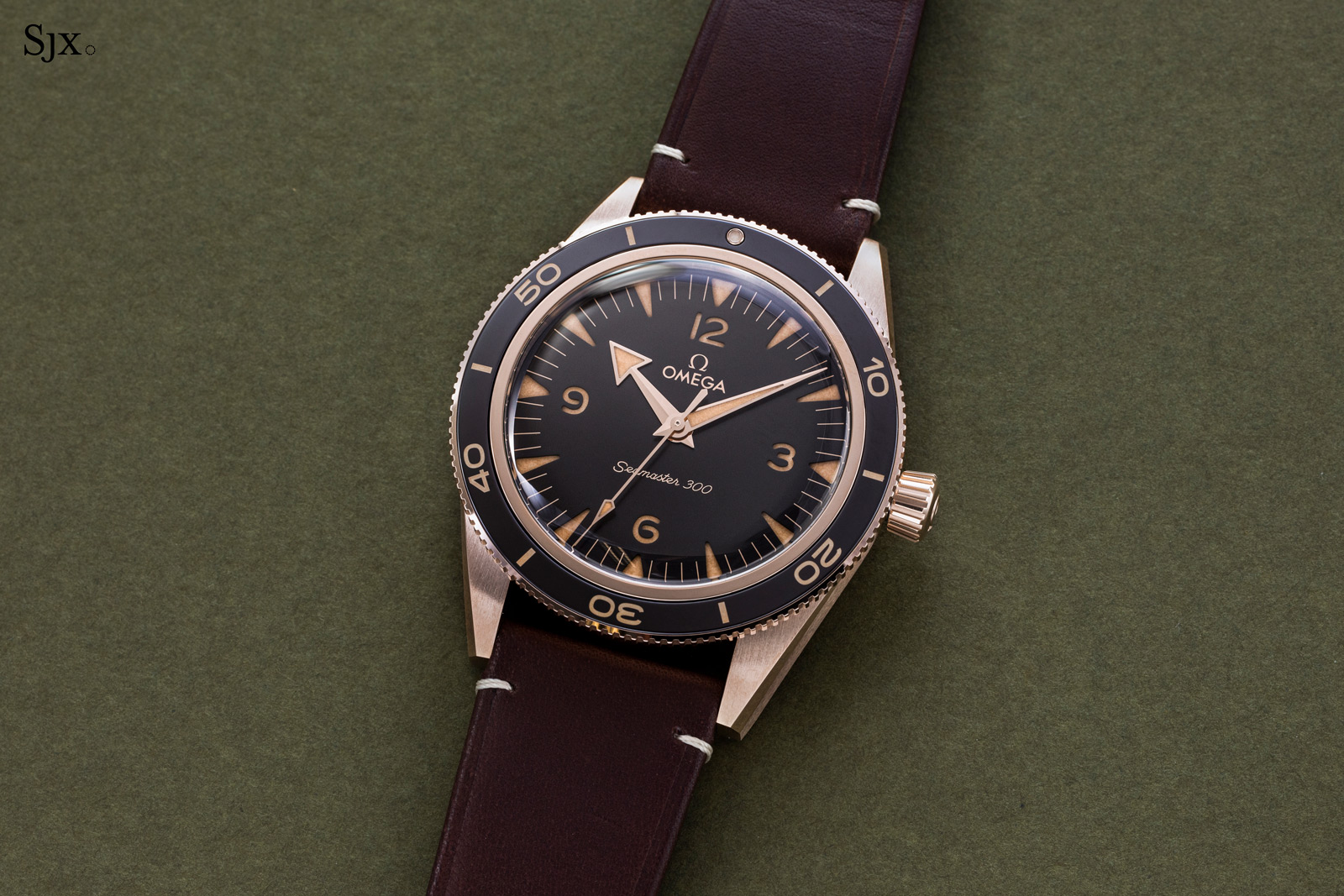
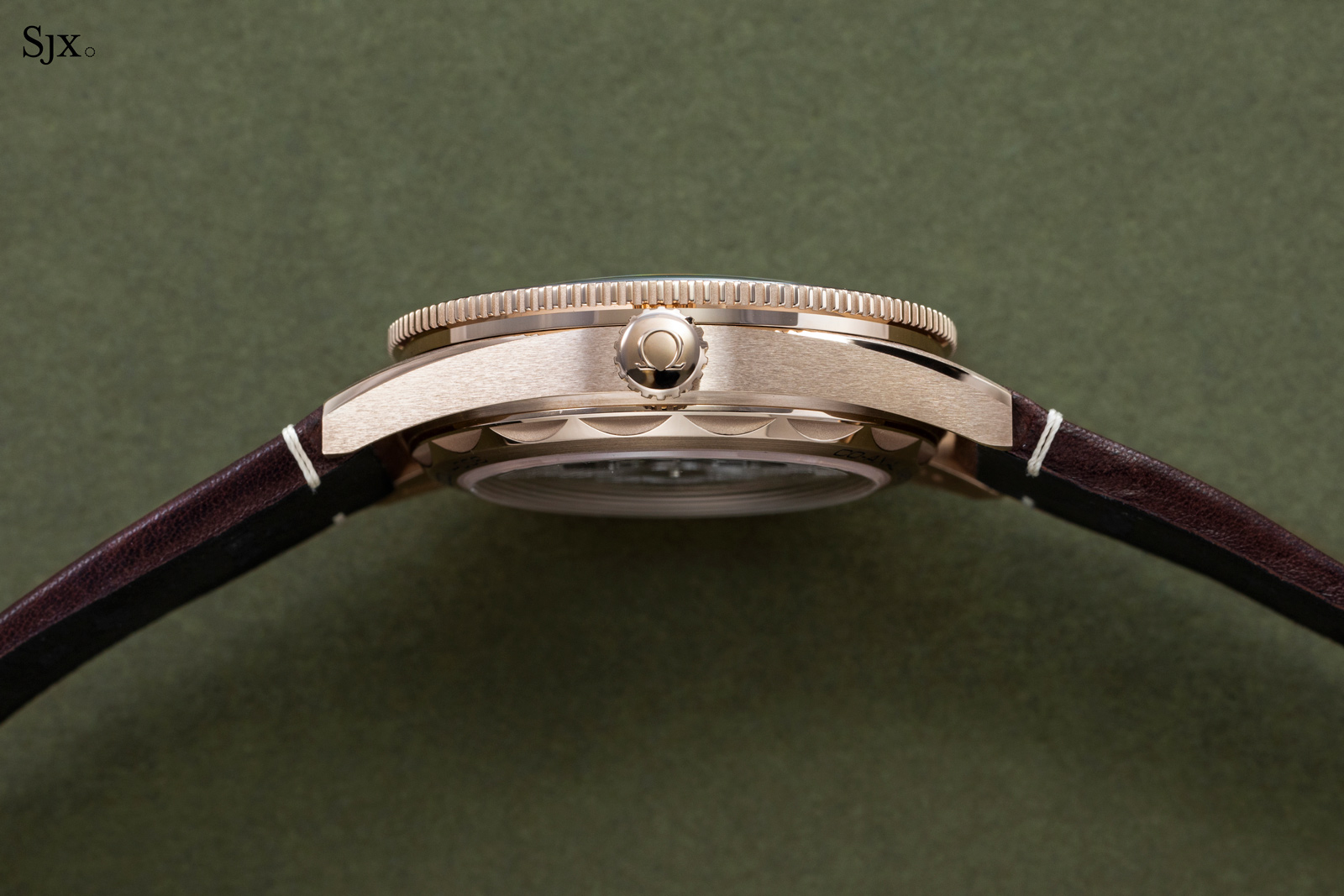
And the in-between quality of the alloy is reflected by the price tag of US$11,200 – half as much as the average solid-gold dive watch, but twice as much as one in steel. That’s fair for a semi-precious metal watch.
On the topic of a precious-metal dive watch at an affordable-ish price, a comparison is inevitable. Unveiled a few months after the Seamaster 300 Bronze Gold, the Tudor Black Bay Fifty-Eight 18K delivers twice as much gold content for a price tag that’s 50% higher.
While Black Bay is unquestionably better value – it does have an 18k gold case – the Seamaster 300 is still an attractive watch. The Seamaster 300 has a slightly more expensive look and feel, thanks to its more elaborate finishing, especially on the case, which has details like mirror polishing for the bevels on the lugs and crown.
In other words, the Seamaster is slightly more luxe, while Tudor is more no-frills. As such, the relative pricing makes sense, so it boils down to personal preference and budget between the two.

The Black Bay Fifty-Eight 18K
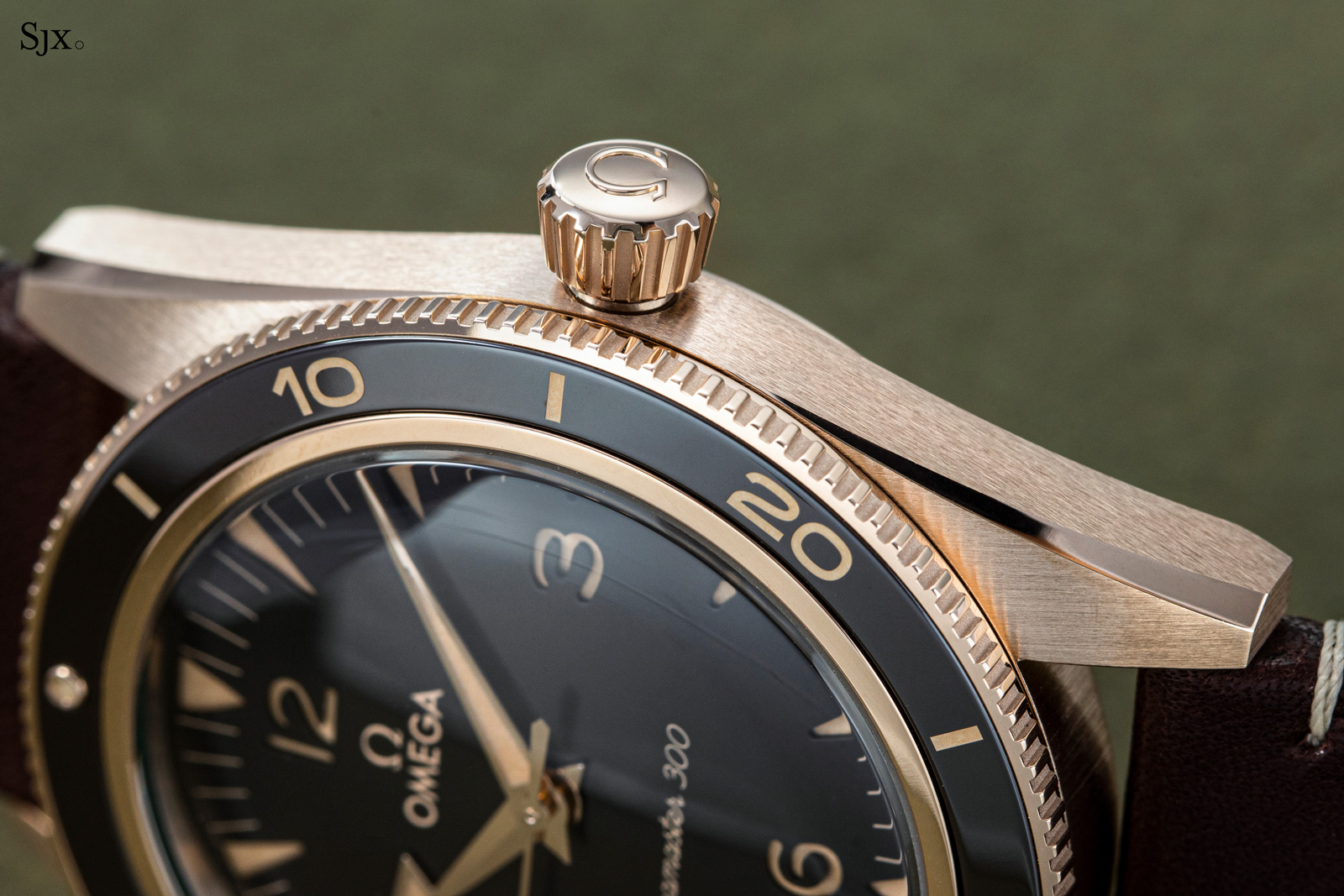
And the Seamaster 300 Bronze Gold
Vintage chocolate
Modelled on Omega’s first-ever professional-diver’s watch, the ref. CK 2913 of 1957, the Seamaster 300 family brings with it the aesthetic of early dive watches. It’s simple and clean – the dial has no date – and stands in stark contrast against most modern Omega dive watches, which tend to have an aggressively sporty design.
But the Seamaster 300 isn’t a one-to-one remake – and it shouldn’t be since Omega has done a few of those – as illustrated by tweaks such as a wider bezel insert as well as the sans serif font for the numerals and logo, all of which add a contemporary touch to the watch.
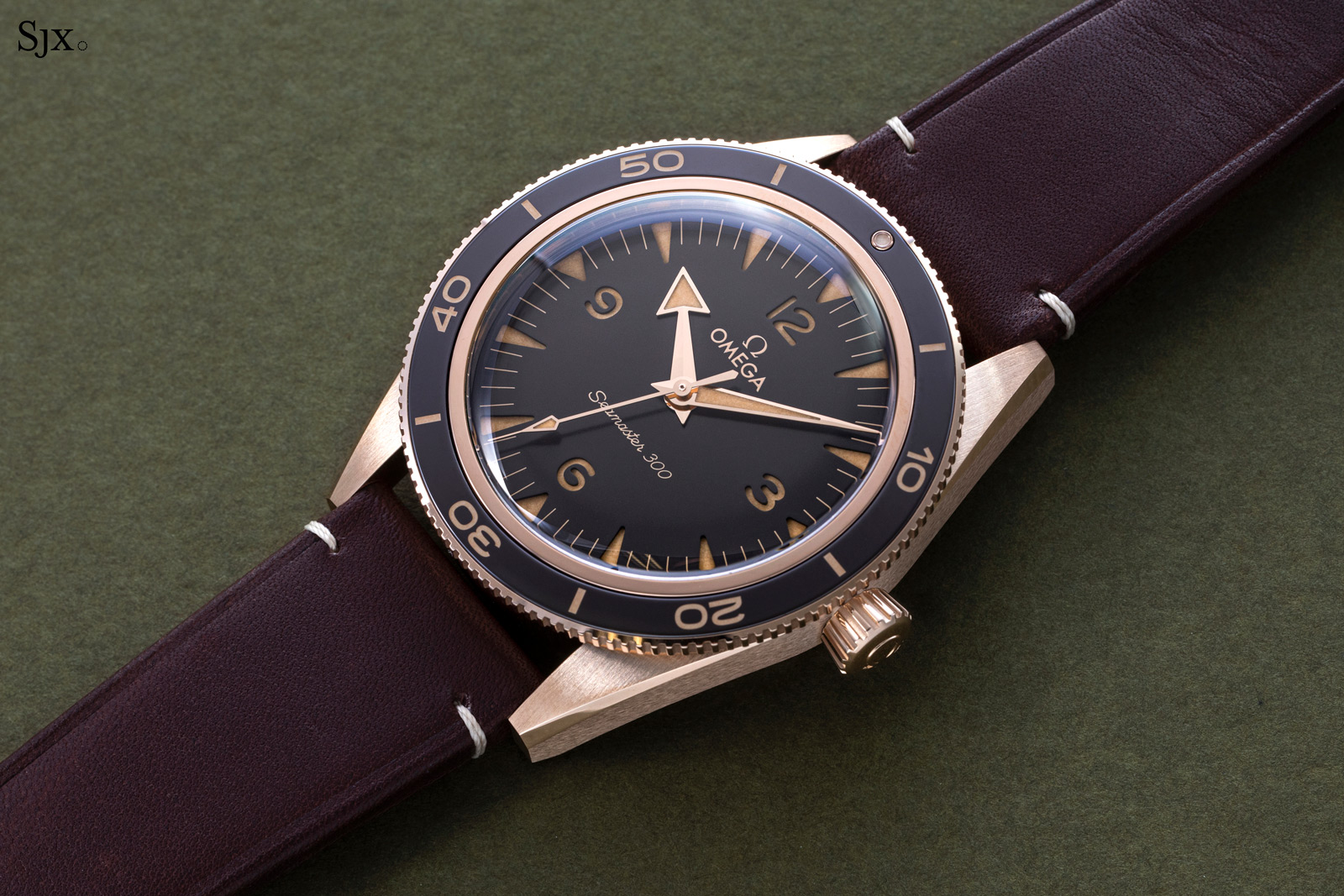
At the same time, the construction of the case components has been streamlined. The bezel does away the large, trapezoidal 12 o’clock marker, leaving the watch looking more elegant.
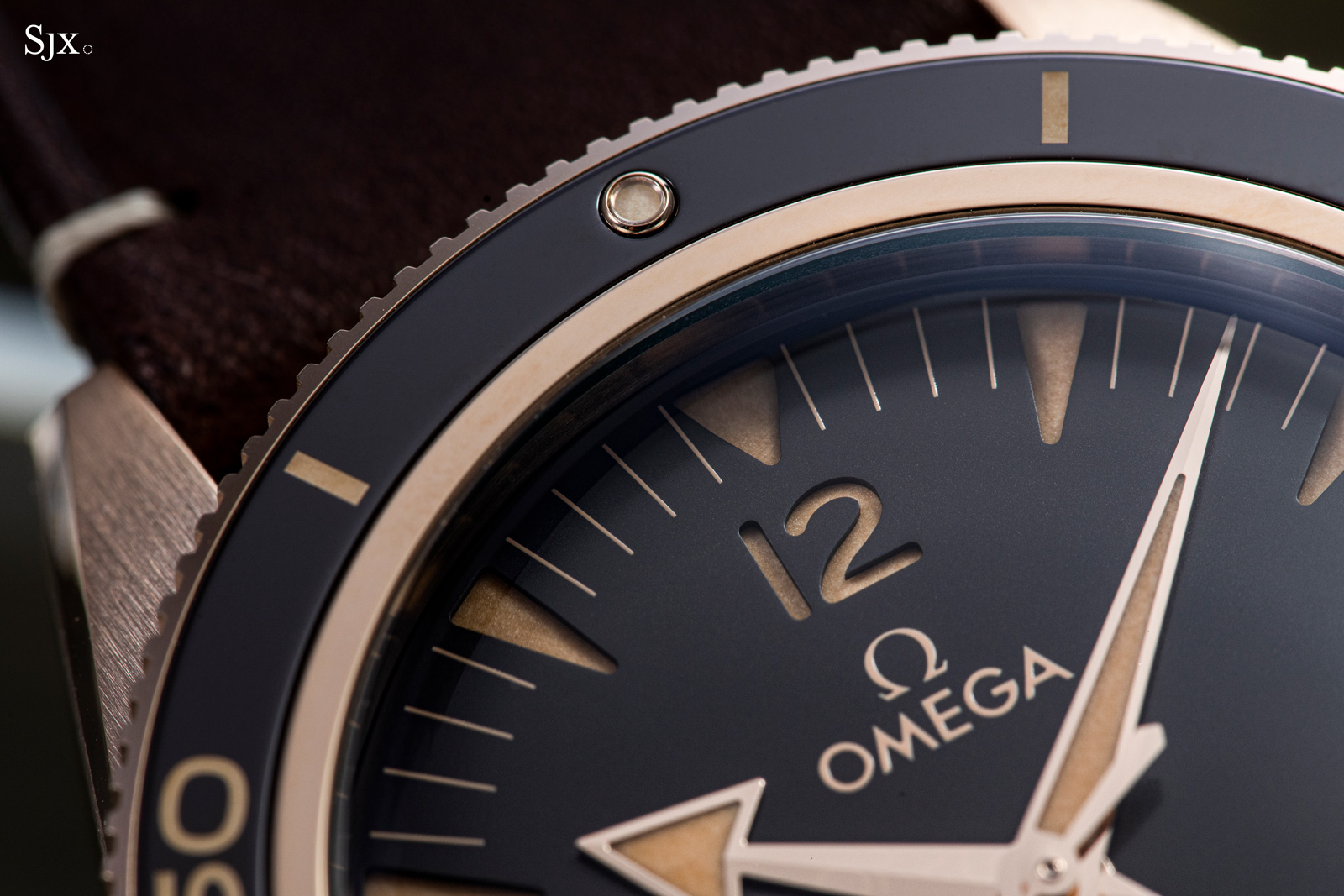
A closeup of the bezel on the Seamaster 300 Bronze Gold
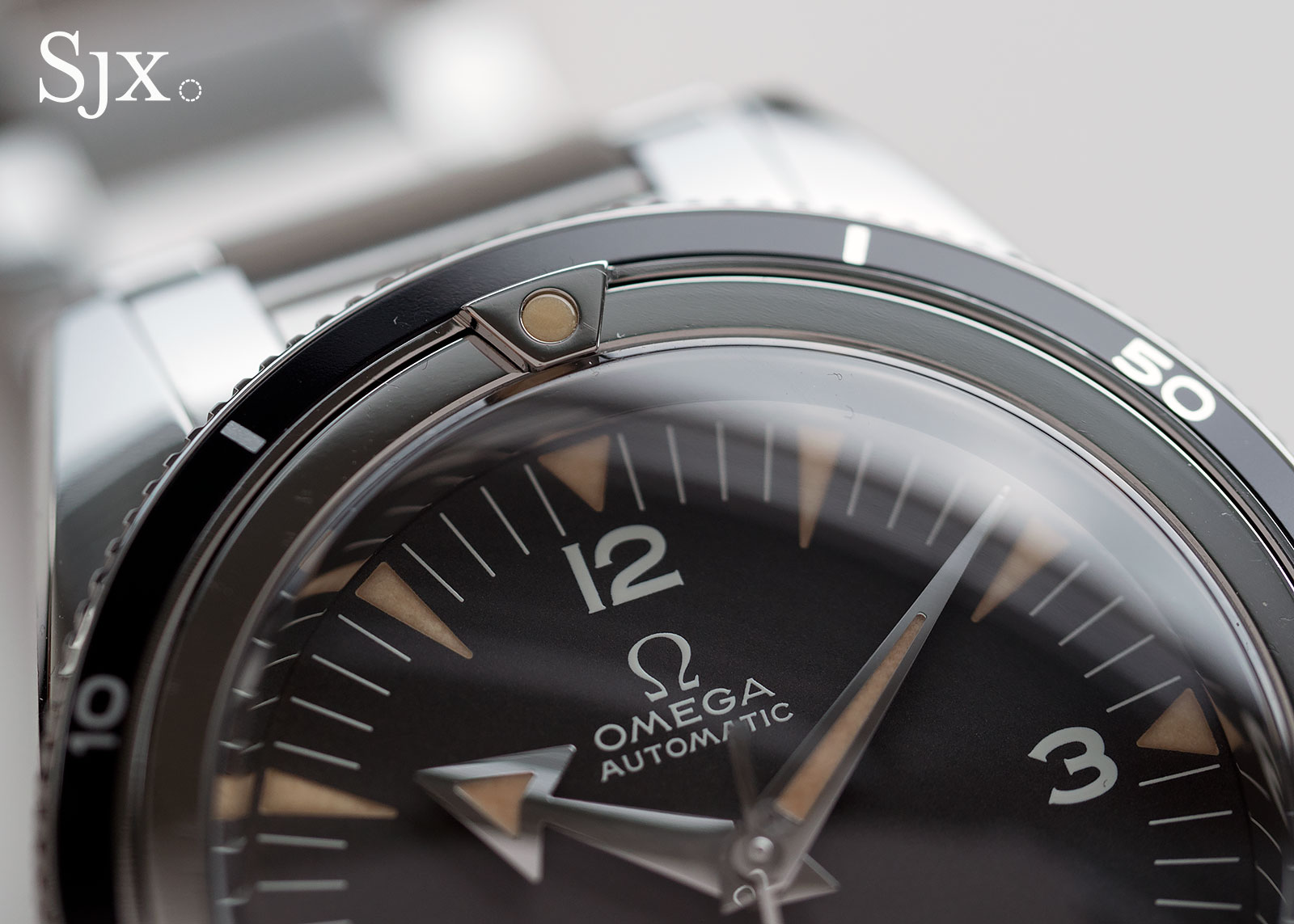
The trapezoidal frame for the lume pip on the Seamaster 300 remake from the 1957 Trilogy, which is a near-exact remake of the original
While the bezel has been simplified, the dial has been made more elaborate on the modern watch . While the vintage original had recesses on the dial that were filled with radium, the modern-day version has a “sandwich” dial. It’s made up of twin dial plates – the top with cut outs for the hour markers and the lower plate printed with Super-Luminova – which give the dial more depth.
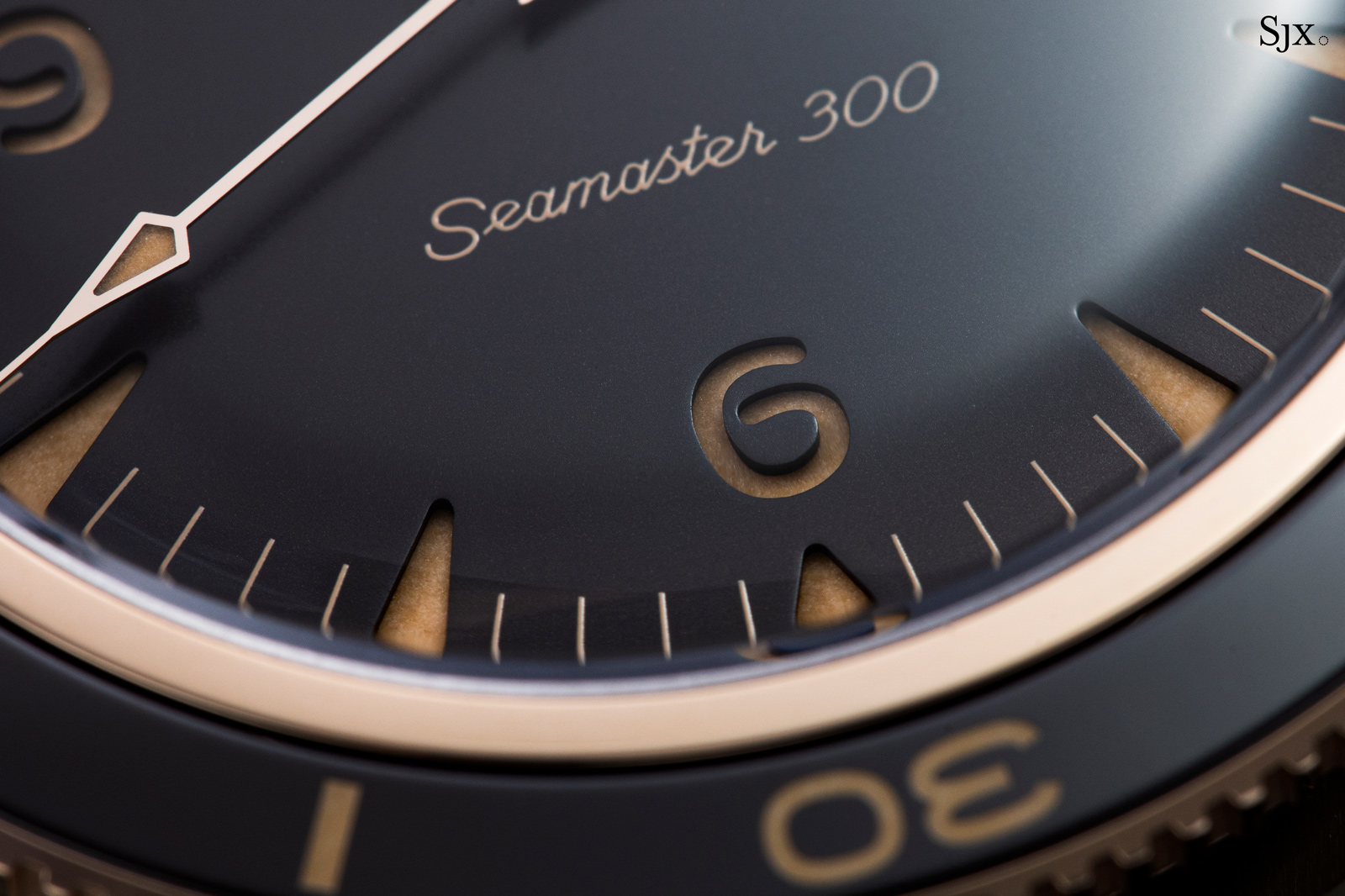
The cut-outs for the hour markers are evident up close
All those details make for a dial that is good looking. During the week I wore it, I found the dial to be especially nuanced, despite its single colour, because the tone of brown changes depending on the light. Made of an oxidised bronze alloy (and not Bronze Gold), the dial appears to be black most of the time, but reveals itself to be a rich, dark brown under bright sunlight.
However, I found it difficult to tell the time with indoor lighting, because the polished hands reflect black at certain angles, causing them to blend into the dial. That was compounded by the fact that the faux-vintage, beige luminescent material is muted in colour, so it too blends into the background. Legibility was, however, excellent outdoors.
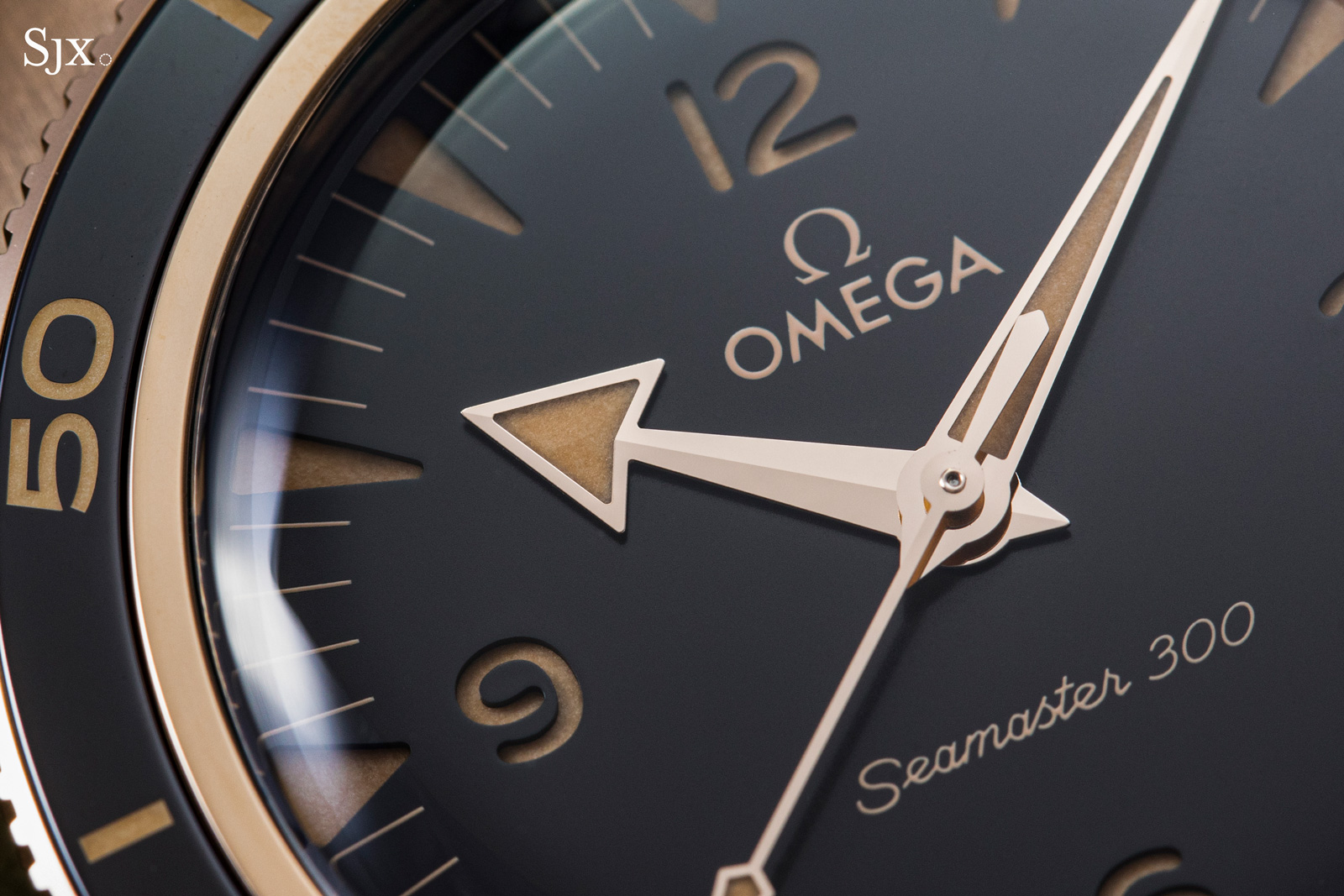
Telling the time in the dark was easy enough, since both bezel and dial are fully “lumed”. But there was one nit to pick – because the minute hand tapers dramatically to a point, most of its tip has no luminescent material. As a result, the effective distance between the hand and bezel is substantial in the dark, which means reading elapsed time on the bezel in the dark is a challenge. Fortunately that doesn’t seem like a pressing task for a watch like this.
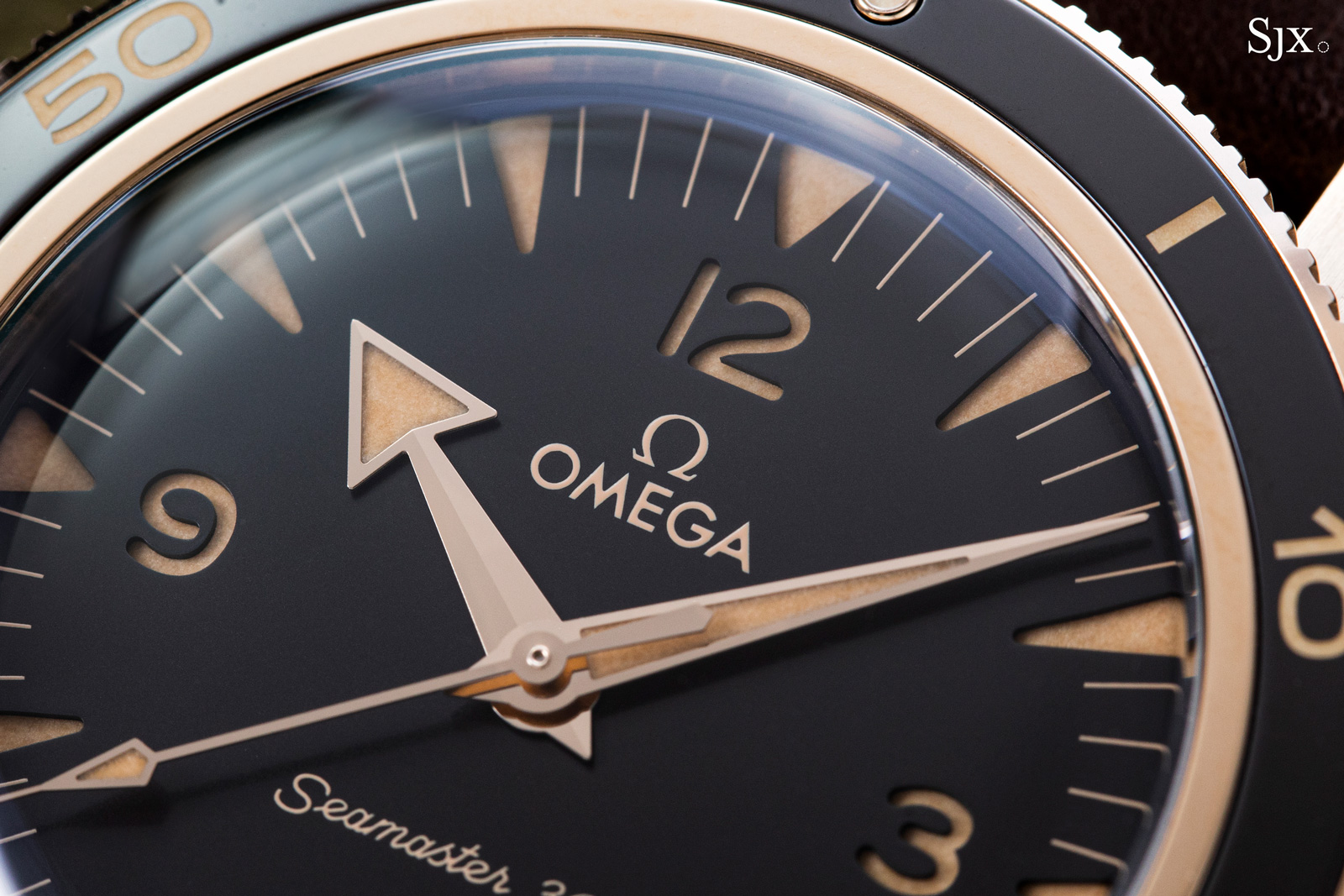
One of the especially attractive details is the domed crystal. The importance of the crystal might not seem obvious, but it makes when looking at it in the metal. When the watch was announced a year ago, the crystal immediately caught my eye – and it didn’t disappoint when I finally got one in hand.
While domed sapphire crystals are common – they are even found in watches that cost hundreds of dollars – the domed crystal on the Seamaster 300 feels to be of higher quality, it just seems clearer. There is none of the edge distortion that is often visible in low-end watches with domed crystals.
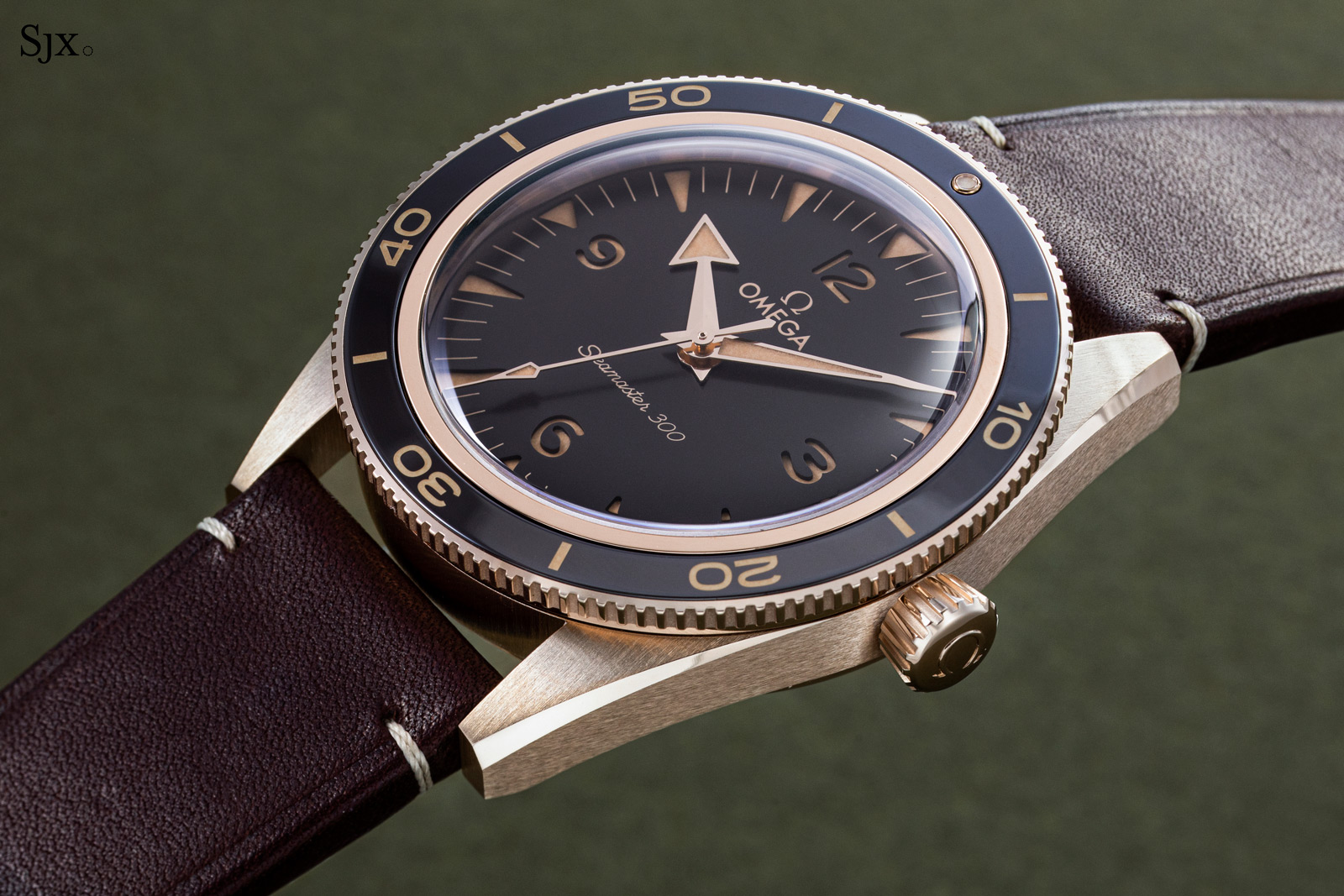
Gently domed and crystal clear
While the default in modern watches with domed crystals is the “box type” sapphire with an obvious edge, the crystal on the Seamaster 300 is gently curved, doing a good job in evoking vintage PlexiGlas, again contributing to the vintage feel.
The quality of the crystal also emphasises the high-quality construction of the Seamaster 300 Bronze Gold, as would be expected for a premium-priced Omega. This gives the watch a tactile feel that lives up to and justifies the price.
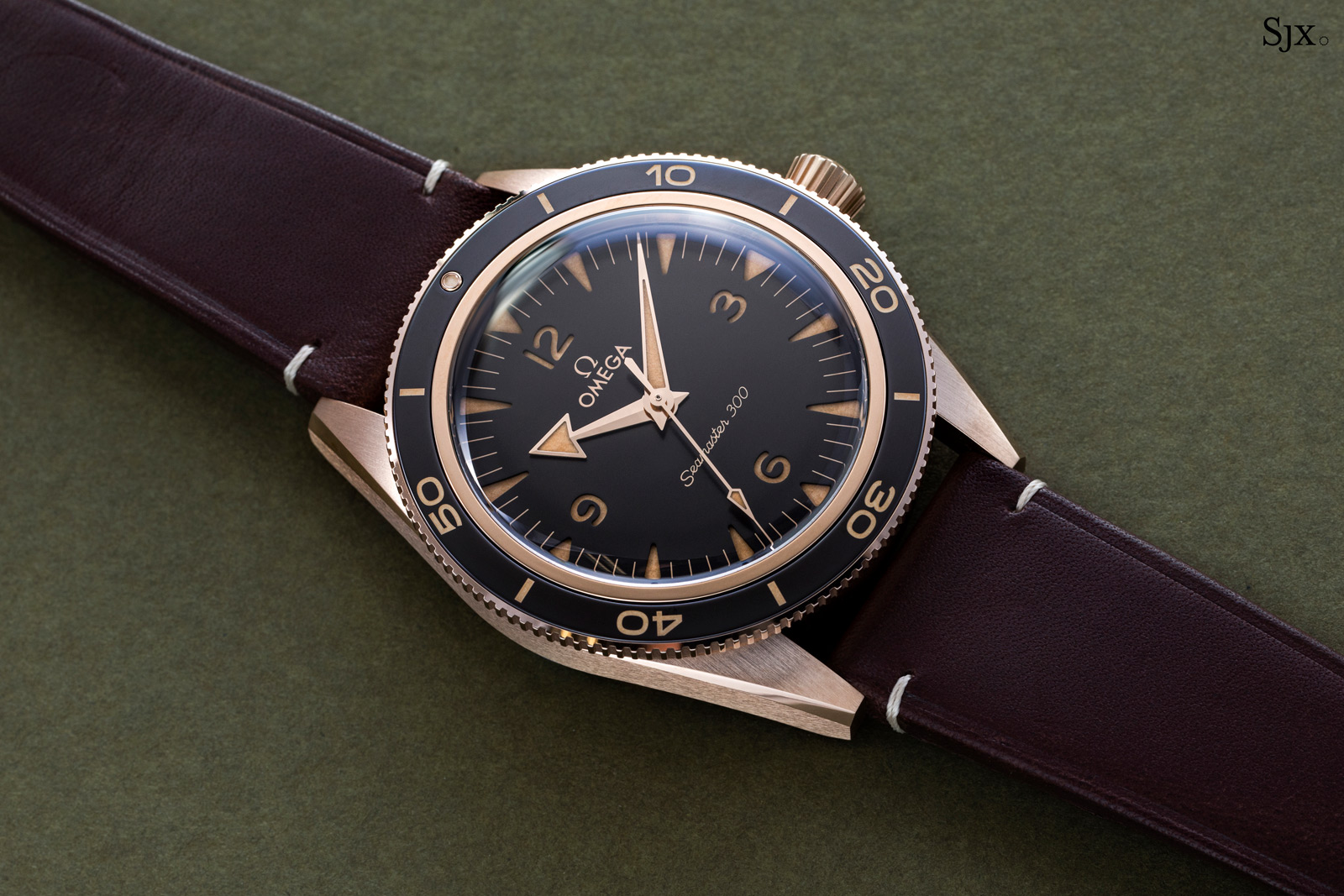
The narrow, glossy ceramic insert on the bezel works well with the warm, luxurious look of Bronze Gold
The appeal of the watch is perhaps not a surprise, since Omega has had some practice with the reimagining the Seamaster 300. The immediate predecessor of the Seamaster 300 Bronze Gold, which is still in the catalogue, is the first-generation model, which was available in conventional 18k gold.
The design has clearly been refined from one generation to another, both in terms of the dial and case. The lines of the case are now more taut, with a wider polished bevel on the lugs. And there’s less text on the dial – “Master Co-Axial” is gone – which now also has a “sandwich” construction. Less obvious but also attractive is the slightly conical crown, which replaces the conventional flat-sided crown on the first generation.
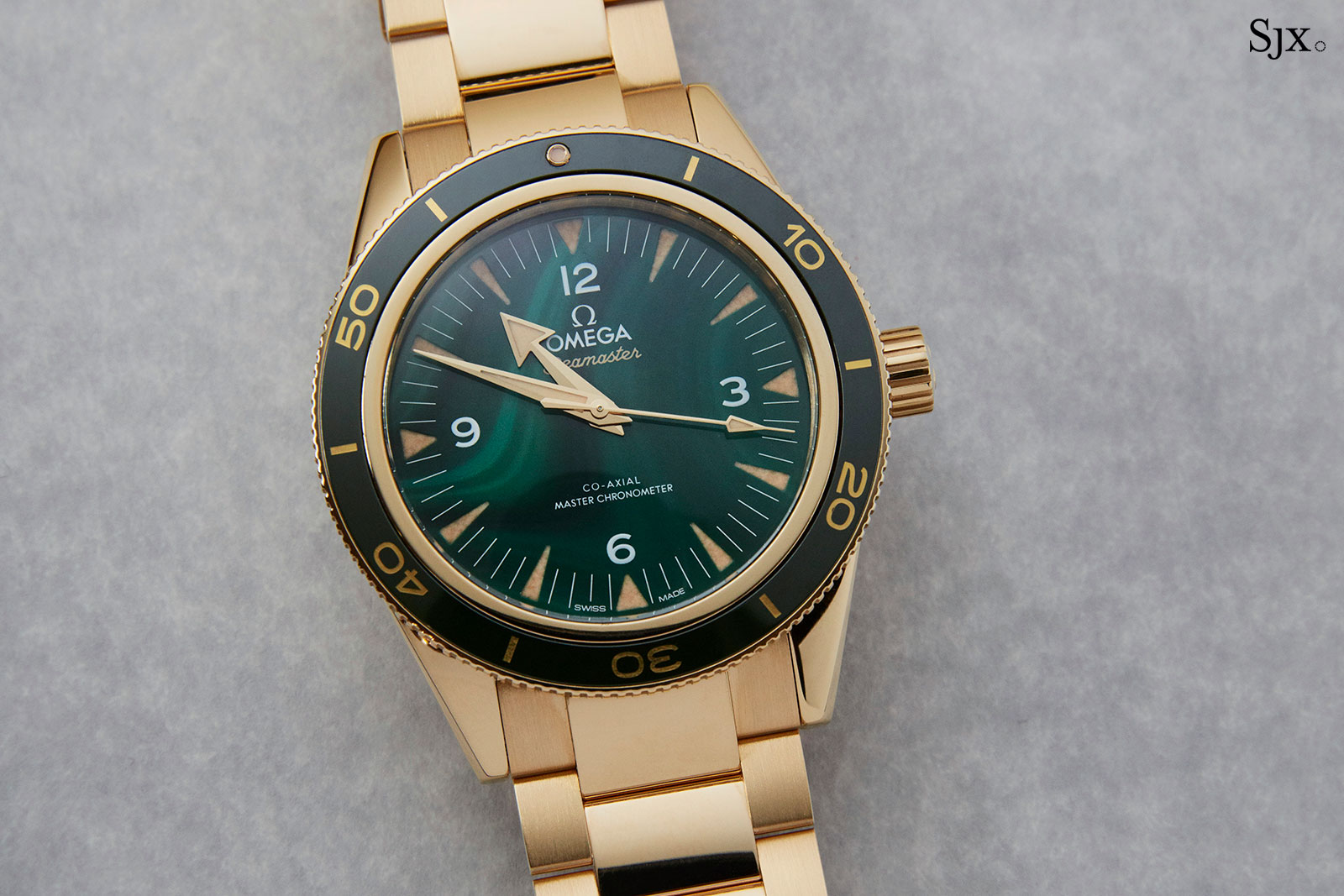
A first-generation Seamaster 300, here in the ultra-luxe, all-gold iteration with a malachite dial
Bronze Gold
But the main feature of the this model is definitely the case and its material, which gives the watch both its attractive palette and unique identity.
According to Gregory Kissling, Omega’s Head of Product Management, Bronze Gold alloy is made up of five metals – copper, gold, palladium, silver, and gallium.
Naturally the majority of the alloy, half of the total in fact, is copper, followed by gold, which accounts for 37.5% of its composition. That makes it 9k gold, an alloy historically used in the United Kingdom, where it could be legally described as gold (other countries required a higher caratage, 14k in the United States for instance).
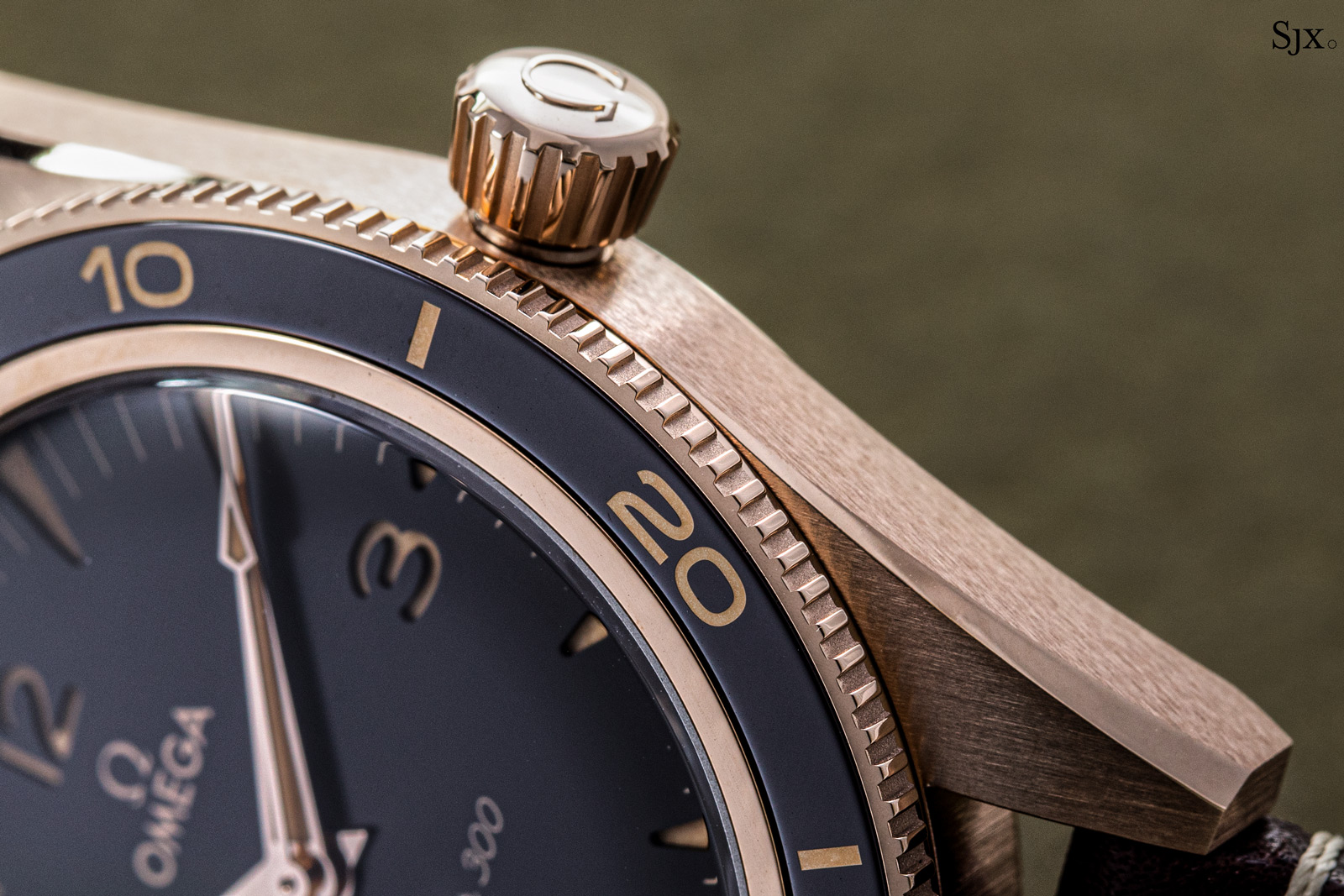
Both the bezel and crown are finished with alternating polished and sandblasted surfaces
Gold is a stable element that increases the corrosion resistance of the alloy, avoiding the pronounced oxidisation of conventional bronze alloys. That oxidisation results in verdigris, a green layer made up of copper oxide that serves to protect the underlying metal from further corrosion, which explains the sunken-treasure look of many bronze watches. Palladium was also added to Bronze Gold to increase its stability.
While Omega states that the watch will not develop a green patina, it makes clear that Bronze Gold will age slowly but surely, which means the case will change colour but gently and gradually. In fact, silver is part of the formula as well to create a more obvious patina. According to Omega, Bronze Gold will acquire a pink hue over time, which is similar to the change of 14k gold over time.
And the final element of the alloy was put in purely for manufacturing purposes: gallium facilitates mixing the alloy.
Solid mechanics
When it comes to reliable, industrial-scale watchmaking, Omega ranks highly with its movements, especially the higher-end calibres. The cal. 8912 inside the Seamaster 300 is an excellent case in point, incorporating almost all of the brand’s modern innovations.
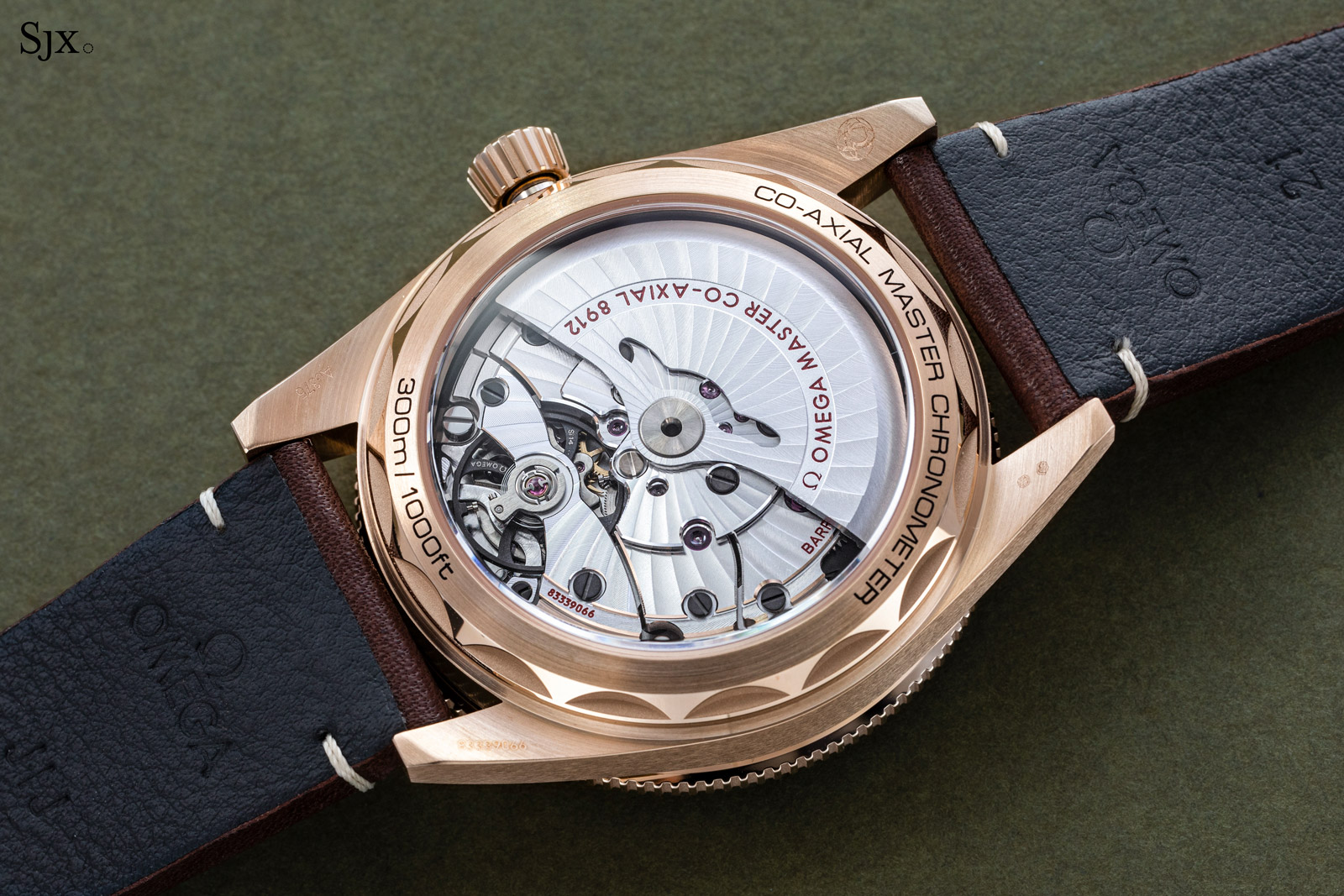
The cal. 8912 scores well in terms of the basics. It has a robust construction with features that are shared across the brand’s in-house movements, such as a full balance bridge that increases timekeeping stability.
And of course it has a Co-Axial escapement made from non-magnetic materials. An especially efficient design invented by the late English watchmaker George Daniels, the Co-Axial doesn’t require lubrication (though Omega still oils the parts for a margin of safety). It works with a free-sprung balance wheel of titanium paired with a silicon hairspring, which gives the movement exceptional resistance to magnetism, hence the Master Chronometer label, which certifies both functionality and magnetism resistance.
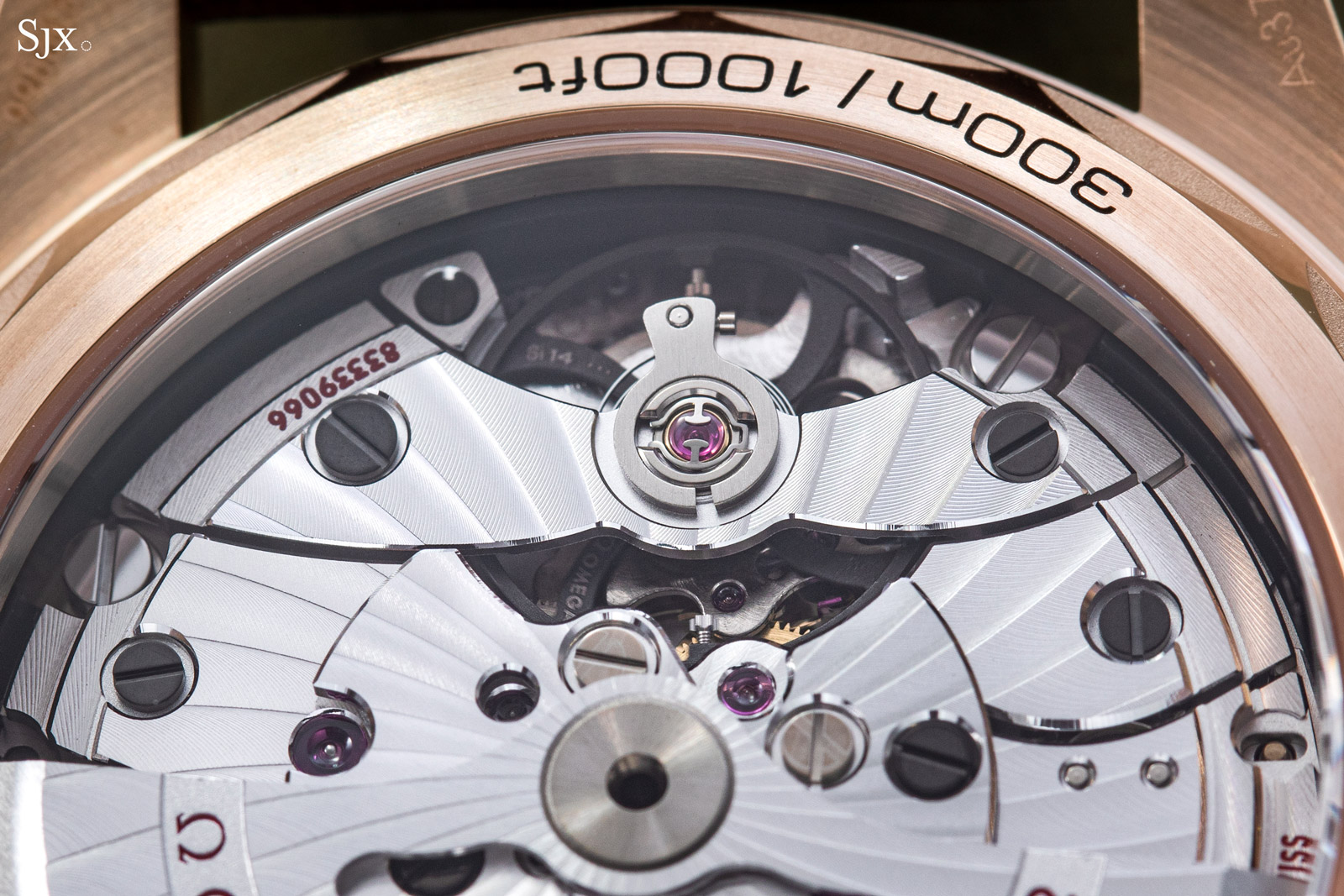
Many of the innovations within the movement are centred on the balance and escapement
Less obvious but no less crucial are the twin barrels operating in series, which are found only in select Omega movements. While the two barrels don’t increase power reserve significantly – up from 55 hours to 60 hours – they do deliver torque in a more stable manner throughout the power reserve, in contrast to the significantly fluctuating torque provided by a single barrel at the start and end of its running time.
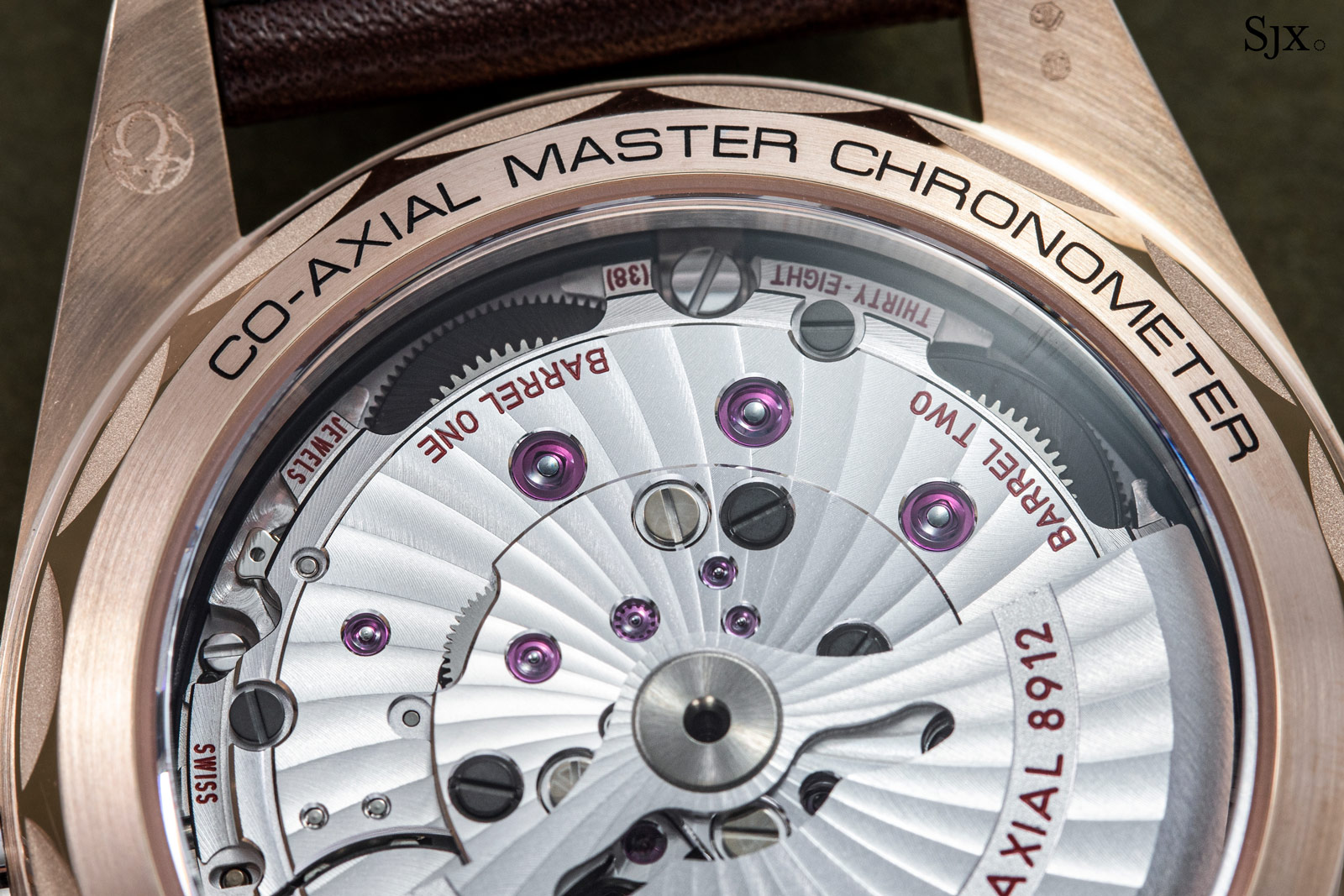
The twin barrels are each marked on the barrel bridge
Just like the case and dial, the movement is cleanly finished, completing the package that makes up the Seamaster 300. The finishing is not artisanal naturally, but it’s smartly done and excellent for an everyday watch in this price segment.
Its defining feature – and perhaps the most attractive element visually – are the Cotes de Geneve executed in spiral, arabesque pattern that exaggerates the play of light that comes naturally with the grained surface of Geneva stripes. This spiral striping has been Omega’s trademark finish for its higher-end movements for almost two decades now, along with the blackened screws and red-filled engraving.
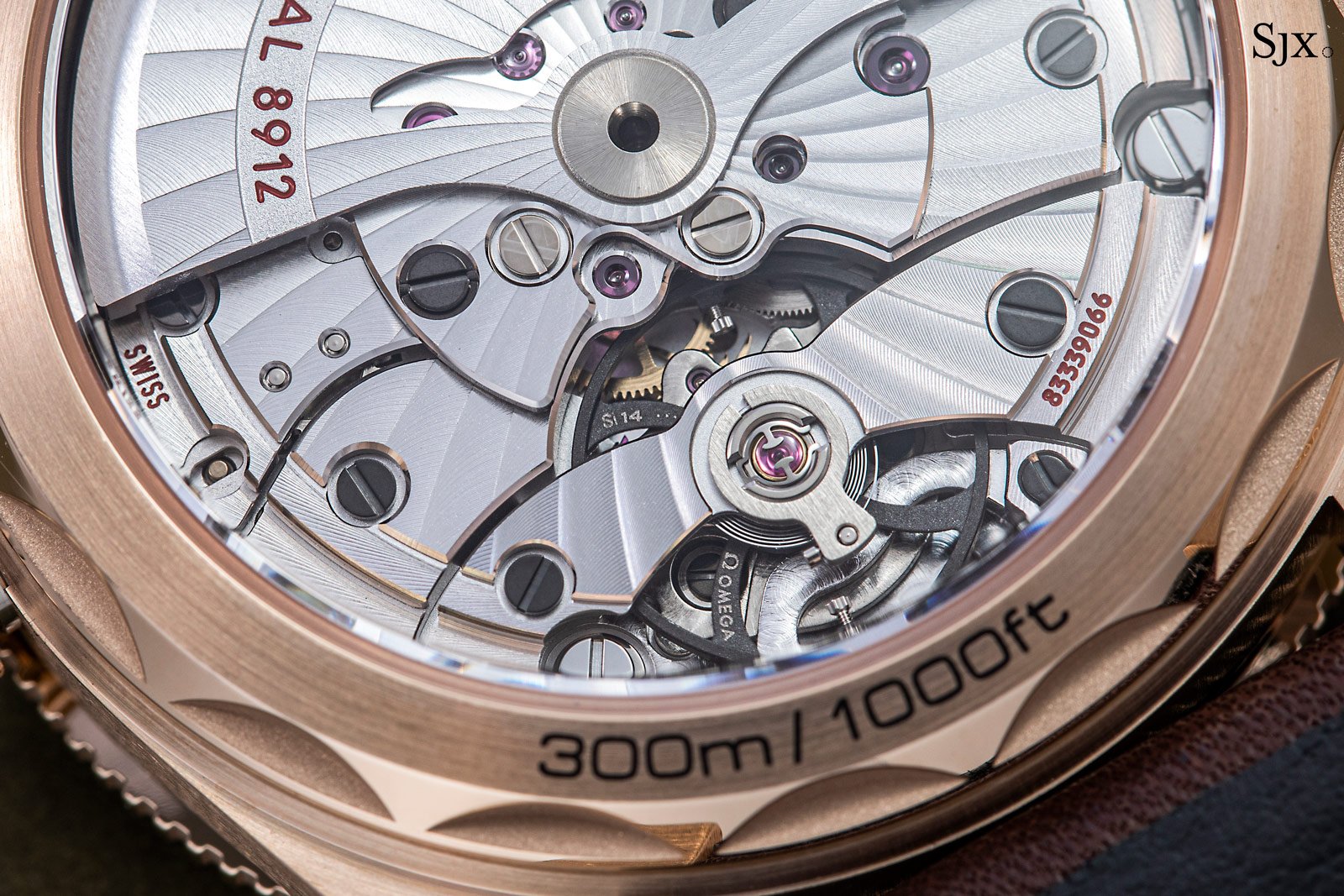
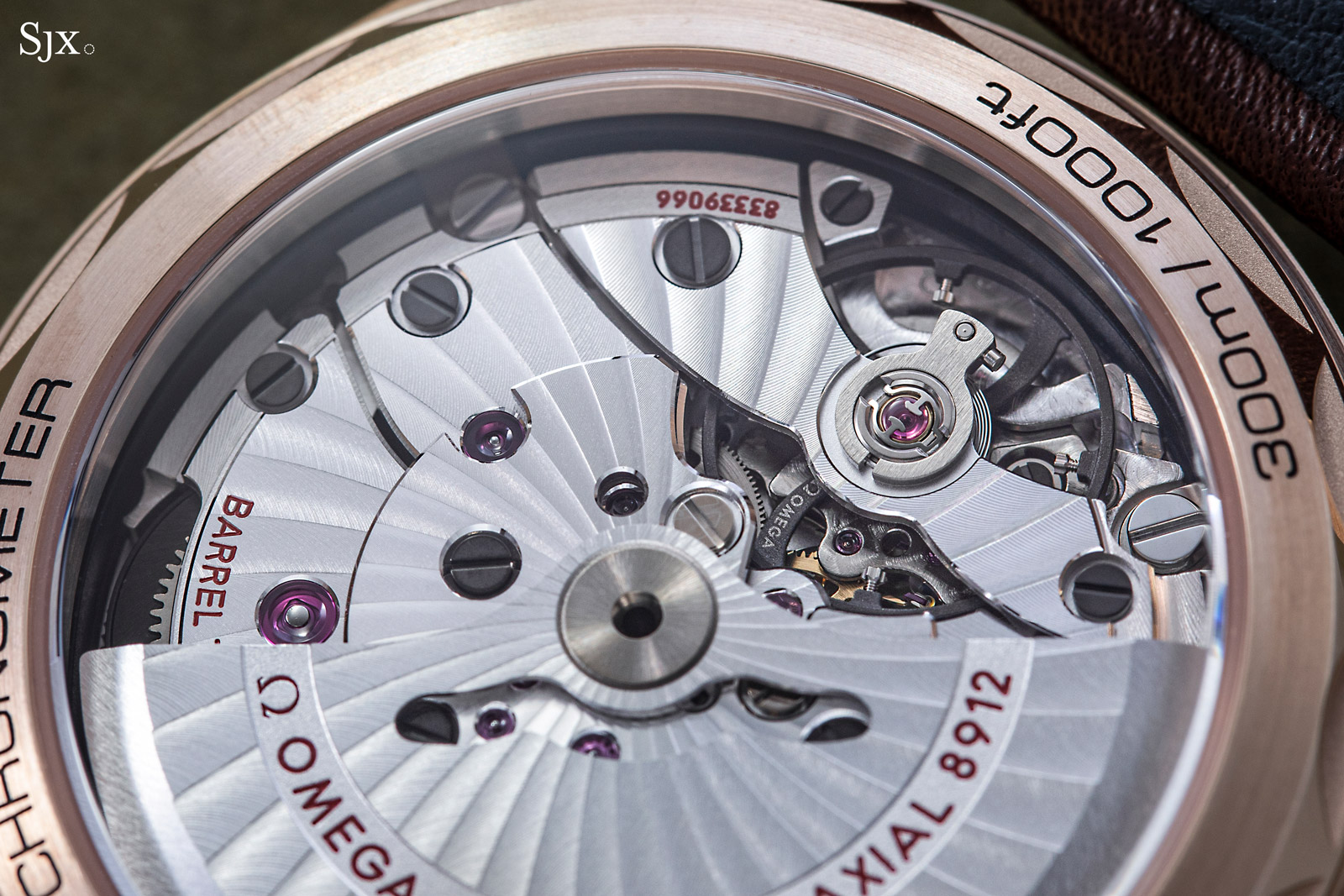
While the stripes are the most obvious element of the decoration, the rest of it is also well done. Notably, the bridges boast polished bevels as well as countersinks.
Both are are done by machine – the vertical milling marks on the bevels are the result of a CNC drill bit doing its thing – but nevertheless attractive. In fact, the countersinks for the jewels and screws are especially attractive, as they catch the light quickly and easily.
One feature missing from the movement, however, is a gold rotor. All solid-gold Omega watches, the 18k gold ones that is, get an upgraded rotor and balance bridge that are in 18k red gold. Having those parts in Bronze Gold would have been a welcome bonus, though cost is probably in factor in why that’s not economical at its current retail price.
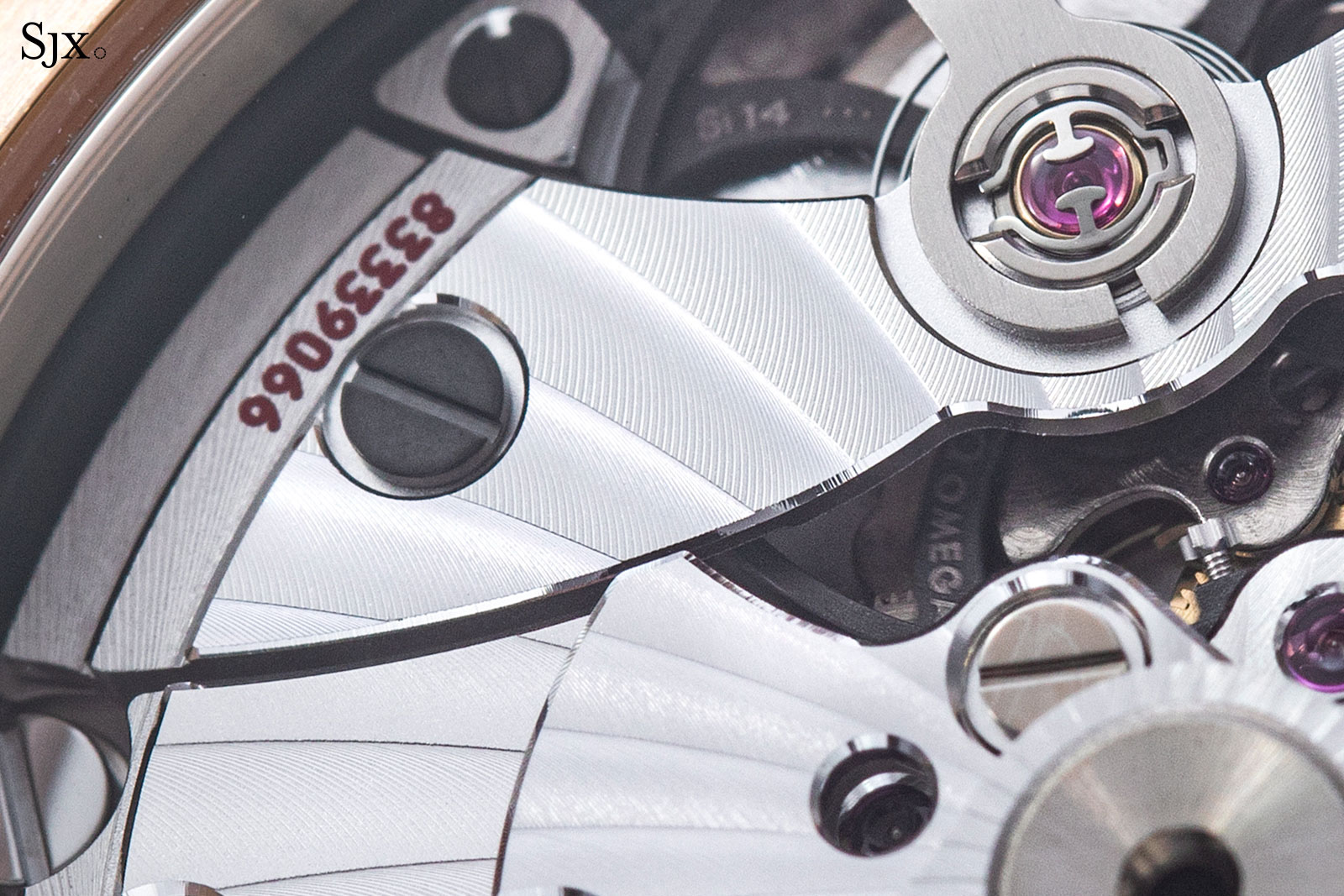
The anglage reveals the telltale vertical graining of automated finishing
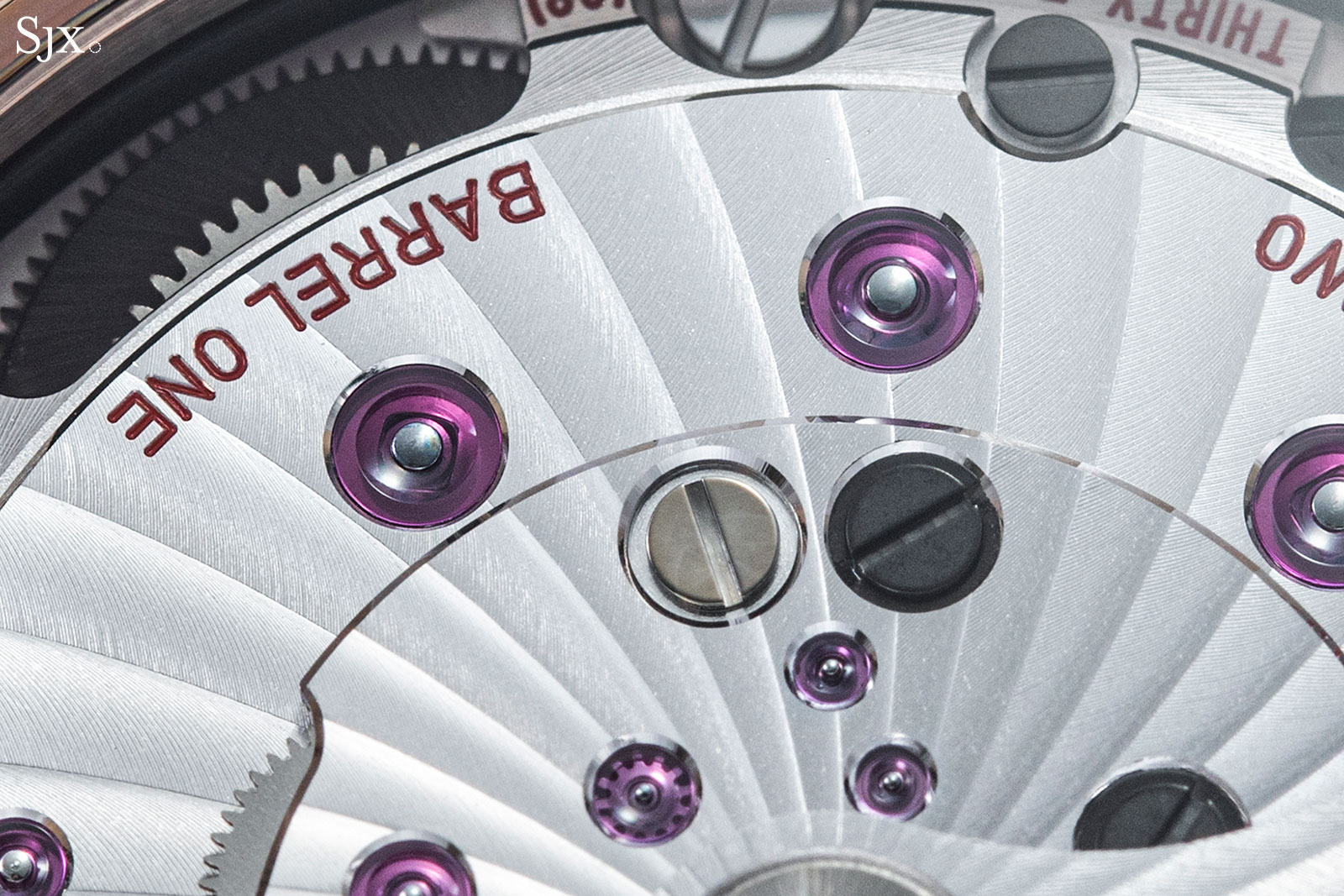
The large jewels for the barrels sit in countersinks
Concluding thoughts
The Seamaster 300 Bronze Gold is a unique proposition in the retro-dive watch category, primarily due to the unique gold alloy, or seen another way, a unique bronze alloy that will retain its golden hue instead of patina. That is an attractive quality for a watch enthusiast who fancies the look of a gold dive watch but isn’t ready to splurge on a conventional, 18k gold diver.
The lower caratage allow, in turn, justifies the price. Even though the Seamaster 300 Bronze Gold costs twice as much as its steel counterpart, it’s ultimately a solid-gold watch, albeit one in 9k gold. Add to that the attractive and unusual palette, and the Seamaster 300 Bronze Gold is indeed an original watch in a crowded category. There isn’t anything comparable on the market, at least not within its price range.
Over the long, I am willing to wager the Bronze Gold will age well – figuratively rather than literally since it will hardly patina – while many of its retro diver peers will fade in relevance and appeal. I arrived at that conclusion because of its simple design and strong execution – and the gold case is unique.
Key facts and price
Omega Seamaster 300 Bronze Gold
Ref. 234.92.41.21.10.001
Diameter: 41 mm
Height: 14.4 mm
Material: Bronze gold
Water resistance: 300 metres
Movement: Cal. 8912
Functions: Hours, minutes, and seconds
Winding: Self-winding
Frequency: 25,200 beats per hour (3.5 Hz)
Power reserve: 60 hours
Strap: Leather strap
Availability: At Omega boutiques and retailers
Price: US$11,200, or 16,550 Singapore dollars
For more information, visit Omegawatches.com.
Back to top.

